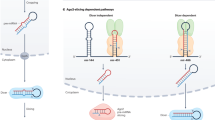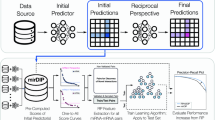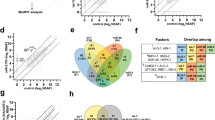Abstract
Target prediction for animal microRNAs (miRNAs) has been hindered by the small number of verified targets available to evaluate the accuracy of predicted miRNA-target interactions. Recently, a dataset of 3,404 miRNA-associated mRNA transcripts was identified by immunoprecipitation of the RNA-induced silencing complex components AIN-1 and AIN-2. Our analysis of this AIN-IP dataset revealed enrichment for defining characteristics of functional miRNA-target interactions, including structural accessibility of target sequences, total free energy of miRNA-target hybridization and topology of base-pairing to the 5′ seed region of the miRNA. We used these enriched characteristics as the basis for a quantitative miRNA target prediction method, miRNA targets by weighting immunoprecipitation-enriched parameters (mirWIP), which optimizes sensitivity to verified miRNA-target interactions and specificity to the AIN-IP dataset. MirWIP can be used to capture all known conserved miRNA-mRNA target relationships in Caenorhabditis elegans at a lower false-positive rate than can the current standard methods.
This is a preview of subscription content, access via your institution
Access options
Subscribe to this journal
Receive 12 print issues and online access
$259.00 per year
only $21.58 per issue
Buy this article
- Purchase on Springer Link
- Instant access to full article PDF
Prices may be subject to local taxes which are calculated during checkout




Similar content being viewed by others
References
Lee, R.C., Feinbaum, R.L. & Ambros, V. The C. elegans heterochronic gene lin-4 encodes small RNAs with antisense complementarity to lin-14. Cell 75, 843–854 (1993).
Ambros, V. The functions of animal microRNAs. Nature 431, 350–355 (2004).
Jackson, R.J. & Standart, N. How do microRNAs regulate gene expression? Sci. STKE 2007, re1 (2007).
Vasudevan, S., Tong, Y. & Steitz, J.A. Switching from repression to activation: microRNAs can up-regulate translation. Science 318, 1931–1934 (2007).
Kloosterman, W.P. & Plasterk, R.H. The diverse functions of microRNAs in animal development and disease. Dev. Cell 11, 441–450 (2006).
Miranda, K.C. et al. A pattern-based method for the identification of MicroRNA binding sites and their corresponding heteroduplexes. Cell 126, 1203–1217 (2006).
Rajewsky, N. microRNA target predictions in animals. Nat. Genet. 38 Suppl, S8–S13 (2006).
Brennecke, J., Stark, A., Russell, R.B. & Cohen, S.M. Principles of microRNA-target recognition. PLoS Biol. 3, e85 (2005).
Lim, L.P. et al. Microarray analysis shows that some microRNAs downregulate large numbers of target mRNAs. Nature 433, 769–773 (2005).
Vella, M.C., Reinert, K. & Slack, F.J. Architecture of a validated microRNA:target interaction. Chem. Biol. 11, 1619–1623 (2004).
Grosshans, H. et al. The temporal patterning microRNA let-7 regulates several transcription factors at the larval to adult transition in C. elegans. Dev. Cell 8, 321–330 (2005).
Johnson, S.M. et al. RAS is regulated by the let-7 microRNA family. Cell 120, 635–647 (2005).
Easow, G., Teleman, A.A. & Cohen, S.M. Isolation of microRNA targets by miRNP immunopurification. RNA 13, 1198–1204 (2007).
Beitzinger, M. et al. Identification of human microRNA targets from isolated argonaute protein complexes. RNA Biol. 4, 76–84 (2007).
Hayes, G.D., Frand, A.R. & Ruvkun, G. The mir-84 and let-7 paralogous microRNA genes of Caenorhabditis elegans direct the cessation of molting via the conserved nuclear hormone receptors NHR-23 and NHR-25. Development 133, 4631–4641 (2006).
Lall, S. et al. A genome-wide map of conserved microRNA targets in C. elegans. Curr. Biol. 16, 460–471 (2006).
Rehmsmeier, M., Steffen, P., Hochsmann, M. & Giegerich, R. Fast and effective prediction of microRNA/target duplexes. RNA 10, 1507–1517 (2004).
Robins, H., Li, Y. & Padgett, R.W. Incorporating structure to predict microRNA targets. Proc. Natl. Acad. Sci. USA 102, 4006–4009 (2005).
Zhao, Y., Samal, E. & Srivastava, D. Serum response factor regulates a muscle-specific microRNA that targets Hand2 during cardiogenesis. Nature 436, 214–220 (2005).
Long, D. et al. Potent effect of target structure on microRNA function. Nat. Struct. Mol. Biol. 14, 287–294 (2007).
Kertesz, M. et al. The role of site accessibility in microRNA target recognition. Nat. Genet. 39, 1278–1284 (2007).
Grimson, A. et al. MicroRNA targeting specificity in mammals: determinants beyond seed pairing. Mol. Cell 27, 91–105 (2007).
Zhang, L. et al. Systematic identification of C. elegans miRISC proteins, miRNAs, and mRNA targets by their interactions with GW182 proteins AIN-1 and AIN-2. Mol. Cell 28, 598–613 (2007).
Ding, Y., Chan, C.Y. & Lawrence, C.E. RNA secondary structure prediction by centroids in a Boltzmann weighted ensemble. RNA 11, 1157–1166 (2005).
Ruby, J.G. et al. Large-scale sequencing reveals 21U-RNAs and additional microRNAs and endogenous siRNAs in C. elegans. Cell 127, 1193–1207 (2006).
Enright, A.J. et al. MicroRNA targets in Drosophila. Genome Biol. 5, R1 (2003).
Didiano, D. & Hobert, O. Perfect seed pairing is not a generally reliable predictor for miRNA-target interactions. Nat. Struct. Mol. Biol. 13, 849–851 (2006).
Stein, L.D. et al. The genome sequence of Caenorhabditis briggsae: a platform for comparative genomics. PLoS Biol. 1, E45 (2003).
Johnston, R.J. & Hobert, O. A microRNA controlling left/right neuronal asymmetry in Caenorhabditis elegans. Nature 426, 845–849 (2003).
Wu, L., Fan, J. & Belasco, J.G. MicroRNAs direct rapid deadenylation of mRNA. Proc. Natl. Acad. Sci. USA 103, 4034–4039 (2006).
Acknowledgements
We thank C. Hammell and all members of the Ambros lab for useful discussions and the Computational Molecular Biology and Statistics Core at the Wadsworth Center for providing computing resources for this work. This research was supported by US National Institutes of Health grants GM34028 and GM066826 to V.A., GM068726 to Y.D. and GM47869 to M. Han as well as US National Science Foundation grant DBI-0650991 to Y.D.; and the Howard Hughes Medical Institute, of which M. Han is an investigator.
Author information
Authors and Affiliations
Corresponding authors
Supplementary information
Supplementary Text and Figures
Supplementary Figures 1–3, Supplementary Tables 1–2, Supplementary Results, Supplementary Methods (PDF 1271 kb)
Supplementary Software
The source code for mirWIP and the RNAhybrid modifications. (ZIP 211 kb)
Rights and permissions
About this article
Cite this article
Hammell, M., Long, D., Zhang, L. et al. mirWIP: microRNA target prediction based on microRNA-containing ribonucleoprotein–enriched transcripts. Nat Methods 5, 813–819 (2008). https://doi.org/10.1038/nmeth.1247
Received:
Accepted:
Published:
Issue Date:
DOI: https://doi.org/10.1038/nmeth.1247
This article is cited by
-
MiR-35 buffers apoptosis thresholds in the C. elegans germline by antagonizing both MAPK and core apoptosis pathways
Cell Death & Differentiation (2019)
-
Predicting microRNA targeting efficacy in Drosophila
Genome Biology (2018)
-
Evaluation and control of miRNA-like off-target repression for RNA interference
Cellular and Molecular Life Sciences (2018)
-
cel-mir-237 and its homologue, hsa-miR-125b, modulate the cellular response to ionizing radiation
Oncogene (2017)
-
miRNAs target databases: developmental methods and target identification techniques with functional annotations
Cellular and Molecular Life Sciences (2017)



